三年级英语上册.Unit5第五单元知识梳理
三年级英语上册第五单元Unit5 (共5课时)

6. I have a pen,a book ________ an eraser. A
A. and
B. and
C. and
本节课我们学习了以下知识,请同学们一定加
强巩固,以便能和同学们进行灵活交流哦! 重点单词: some, please 重点句式: I’d like some juice, please. Here you are. Have some bread, too. I’d like some bread and eggs.
最后两个用and连接。
例句:I’d like some water,milk and juice. 我想要一些水、牛奶和果汁。
“长鼻子”游戏 请同学们以学习小组为单位,试着用 I’d like some... 说句子,看哪一组说的句子最长且 用时最短。
一、单项选择。 1. 如果你想要面包,可以说:________. A
B
A. I like some milk.
B. I’d like some milk,please.
some 的用法 some pron. (代词)表示“一些”,可以修饰可数名 词或者不可数名词,常用于肯定句中。 例如:some rulers 一些尺子
some juice 一些 果汁
I have some books.我有一些书。
朋友。如果客人需要的话,其肯定的回答是 “Thank you. 谢谢你。”或“Thanks.谢谢。”如 果不需要,用“No, thank you.不,谢谢你。”或 “No, thanks.不,谢谢。”来回答。
例句:—Have some bread.吃些面包吧。 易错点 提示
—Thanks.谢谢。/ No, thanks.不,谢谢。
(PEP)人教版三年级上册英语Unit5 Let's eat!单元整体分析
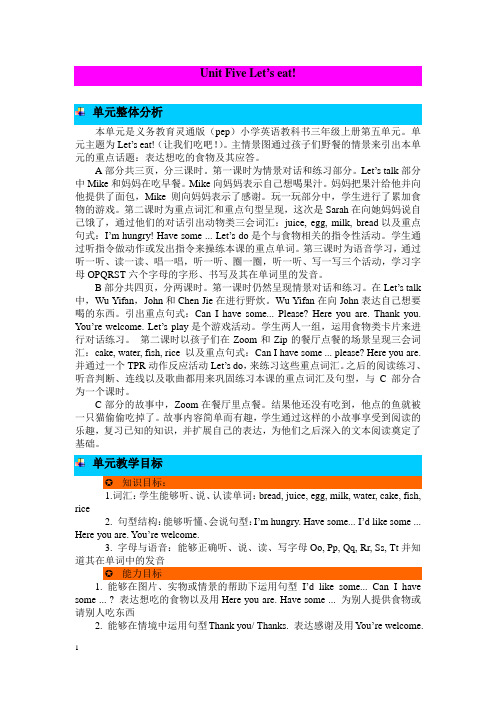
Unit Five Let’s eat!单元整体分析本单元是义务教育灵通版(pep)小学英语教科书三年级上册第五单元。
单元主题为Let’s eat!(让我们吃吧!)。
主情景图通过孩子们野餐的情景来引出本单元的重点话题:表达想吃的食物及其应答。
A部分共三页,分三课时。
第一课时为情景对话和练习部分。
Let’s talk部分中Mike和妈妈在吃早餐。
Mike向妈妈表示自己想喝果汁。
妈妈把果汁给他并向他提供了面包,Mike则向妈妈表示了感谢。
玩一玩部分中,学生进行了累加食物的游戏。
第二课时为重点词汇和重点句型呈现,这次是Sarah在向她妈妈说自己饿了,通过他们的对话引出动物类三会词汇:juice, egg, milk, bread以及重点句式:I’m hungry! Have some ... Let’s do是个与食物相关的指令性活动。
学生通过听指令做动作或发出指令来操练本课的重点单词。
第三课时为语音学习,通过听一听、读一读、唱一唱,听一听、圈一圈,听一听、写一写三个活动,学习字母OPQRST六个字母的字形、书写及其在单词里的发音。
B部分共四页,分两课时。
第一课时仍然呈现情景对话和练习。
在Let’s talk 中,Wu Yifan,John和Chen Jie在进行野炊。
Wu Yifan在向John表达自己想要喝的东西。
引出重点句式:Can I have some... Please? Here you are. Thank you. You’re welcome. Let’s play是个游戏活动。
学生两人一组,运用食物类卡片来进行对话练习。
第二课时以孩子们在Zoom和Zip的餐厅点餐的场景呈现三会词汇:cake, water, fish, rice 以及重点句式:Can I have some ... please? Here you are. 并通过一个TPR动作反应活动Let’s do,来练习这些重点词汇。
(PEP)人教版三年级上册英语Unit5 Let's eat!单元整体分析1-4
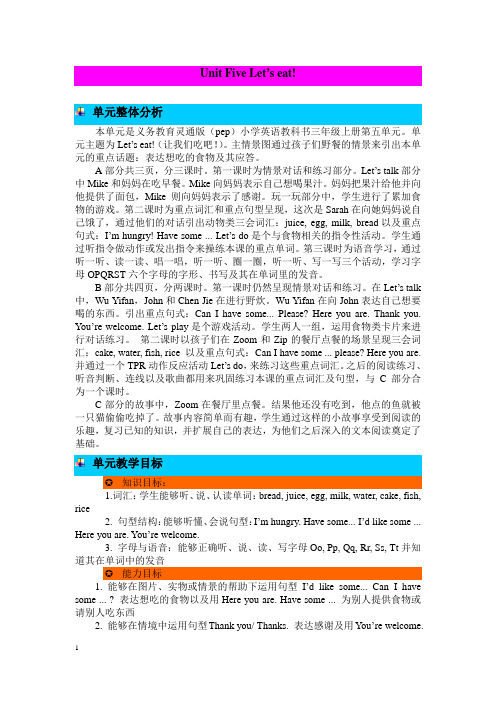
Unit Five Let’s eat!单元整体分析本单元是义务教育灵通版(pep)小学英语教科书三年级上册第五单元。
单元主题为Let’s eat!(让我们吃吧!)。
主情景图通过孩子们野餐的情景来引出本单元的重点话题:表达想吃的食物及其应答。
A部分共三页,分三课时。
第一课时为情景对话和练习部分。
Let’s talk部分中Mike和妈妈在吃早餐。
Mike向妈妈表示自己想喝果汁。
妈妈把果汁给他并向他提供了面包,Mike则向妈妈表示了感谢。
玩一玩部分中,学生进行了累加食物的游戏。
第二课时为重点词汇和重点句型呈现,这次是Sarah在向她妈妈说自己饿了,通过他们的对话引出动物类三会词汇:juice, egg, milk, bread以及重点句式:I’m hungry! Have some ... Let’s do是个与食物相关的指令性活动。
学生通过听指令做动作或发出指令来操练本课的重点单词。
第三课时为语音学习,通过听一听、读一读、唱一唱,听一听、圈一圈,听一听、写一写三个活动,学习字母OPQRST六个字母的字形、书写及其在单词里的发音。
B部分共四页,分两课时。
第一课时仍然呈现情景对话和练习。
在Let’s talk 中,Wu Yifan,John和Chen Jie在进行野炊。
Wu Yifan在向John表达自己想要喝的东西。
引出重点句式:Can I have some... Please? Here you are. Thank you. You’re welcome. Let’s play是个游戏活动。
学生两人一组,运用食物类卡片来进行对话练习。
第二课时以孩子们在Zoom和Zip的餐厅点餐的场景呈现三会词汇:cake, water, fish, rice 以及重点句式:Can I have some ... please? Here you are. 并通过一个TPR动作反应活动Let’s do,来练习这些重点词汇。
沪教牛津版小学英语三起点三年级上册 Unit-5-My-family知识点总结教案
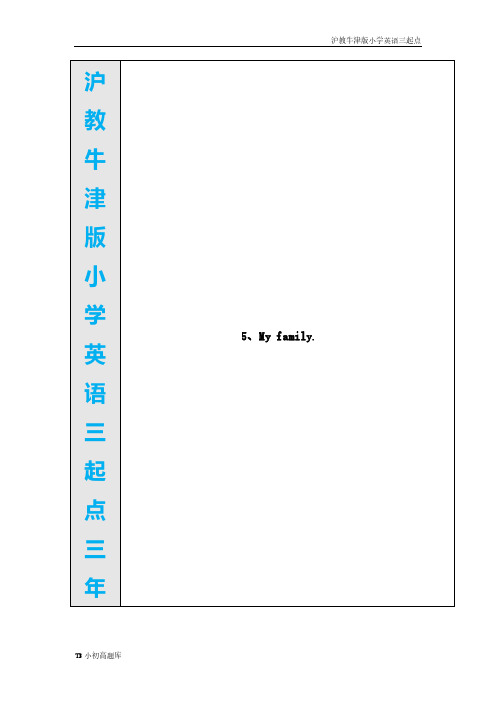
TB 小初高题库
沪教牛津版小学英语三起点
T:(point to the mother in the picture) Who is she?She is Peter’s mother. Mother,mother.
Ss:Mother,mother. T:(point to the father in the picture) Who is he? He is Peter’s brother.Brother,brother. Ss:Brother,brother. T:(point to the girl t in the picture) Who is she? She is Peter’s sister.Sister,sister. Ss:Sister,sister. 2.出示 Unit 2 的 Look and Learn 中 Kitty 一家的图片,然后将这个图 片借助多媒体变成一棵 family tree,然后让学生操练家庭成员的称谓。 T:(show the right picture in “Look and learn”of Unit 2) This is a picture of the Lis(point to Mr Li in the picture)Who is he? S1:Mr Li. T:(point to Mrs Li in the picture) Who is she? S2:Mrs Li. T:(point to the boy in the picture) Who is he?Tell me his English name. S3:Ben. T:(point to the girl in the picture) Who is she? Tell me her English name. S3:Kitty. T:(show the family tree of the Lis) Look here. This is a family tree of the Lis. (point to Kitty in the picture)This is Kitty. (point to Mr Li in the family tree)This is Mr Li.He’s Kitty’s father.Father,father. Ss:Father,father. T:(point to Mrs Li in the family tree)This is Mrs Li.She’s Kitty’s Mother.Mother,mother. Ss:Mother,mother. (point to Ben in the family tree)This is Ben.He’s Kitty’s brother.Brother,brother. Ss: Brother,brother. (point to Kitty in the family tree)This is Kitty.She’s Ben’s sister. Sister,sister. Ss:Sister,sister. 3.播放 Listen and say 的录音,学生逐句跟读,初步感知新授句型
新人教版小学英语三年级上册Unit 5 第五单元

Unit five Let's eat!第5单元我们来吃东西吧!I'd like some bread, please.请给我一些面包。
Here you are.给你。
Can I have some milk?我能喝些牛奶吗?Here you are.给你。
Thanks.谢谢。
You're welcome.不客气。
Have some cake.吃些蛋糕吧。
Thank you.谢谢你。
A Let's talk.一起谈论。
I'd like some juice, please.请给我一些果汁。
Here you are.给你。
Have some bread, too.也吃些面包吧。
Thanks.谢谢。
Let's learn.我们来学习。
Mum, I'm hungry!妈妈,我饿了!Have some bread.吃些面包吧。
juice果汁egg蛋milk牛奶bread面包Let's do.我们来做一做。
Have some eggs.吃些鸡蛋。
Have some juice.喝些果汁。
Eat some bread.吃些面包。
Drink some milk.喝些牛奶。
Letters and sounds.字母和发音。
Listen, repeat and chant.听,重复并吟唱。
O o on orangeO 在……上面橙子P p pig penP 猪钢笔Q q queen quietQ 皇后安静的R r rice redP 米饭红色的S s six SarahS 六萨拉T t tiger tenT 老虎十O o on orange O在……上面橙子P p pig penP 猪钢笔Q q queen quietQ 皇后安静的R r rice redR 米饭红色的S s six SarahS 六萨拉T t tiger tenT 老虎十Listen and circle.听录音并画圈。
三年级上册英语书第五单元

三年级上册英语书第五单元Unit 5: My FamilyIn the fifth unit of the English textbook for third graders, students learn about the topic of "My Family." This unit focuses on introducing family members, describing their appearances and personalities, and talking about family activities. Through engaging activities and exercises, students enhance their vocabulary, grammar, listening, speaking, reading, and writing skills. Let's dive into the content of this unit.Lesson 1: Family MembersIn this lesson, students are introduced to various family members. They learn the names of family members such as father, mother, brother, sister, and grandparents. They practice saying and recognizing these family members using flashcards, pictures, and word games. Additionally, they practice simple phrases like "This is my father" or "She is my sister" to describe their own families.Lesson 2: Appearances and PersonalitiesBuilding upon their knowledge of family members, students now learn basic adjectives to describe physical appearances and personalities. They learn words like tall, short, thin, fat, kind, and helpful. Through role-playing activities, they describe their family members using these adjectives. This lesson helps students develop their speaking and listening skills, as well as expand their vocabulary.Lesson 3: Family ActivitiesIn this lesson, students discuss and learn how to talk about common family activities. They explore different activities such as eating together, going to the park, watching movies, and playing games. Through group discussions and pair work, they practice constructing sentences like "My family likes to play games" or "We often go to the park on weekends." By engaging in these activities, students improve their speaking and writing abilities.Lesson 4: My Family TreeThis lesson focuses on visualizing and understanding family relationships through the concept of a "family tree." Students learn how to draw and interpret a simple family tree. They practice identifying family members and their relationships based on the tree structure. This lesson helps students comprehend the connections between different family members and solidify their vocabulary knowledge.Lesson 5: My Family AlbumThe final lesson of the unit incorporates listening and speaking skills as students create and present a family album. They gather photos of their family members and describe them in English. This activity encourages students to utilize the vocabulary and grammar learned throughout the unit. By sharing their family albums with classmates, they enhance their communication skills and gain confidence in expressing themselves in English.ConclusionUnit 5 of the third-grade English textbook successfully introduces students to the topic of "My Family." Through the lessons on family members, appearances, personalities, activities, family trees, and family albums, students develop their language skills and gain a better understanding of the concept of family. By actively participating in various activities and exercises, students enhance their vocabulary, grammar, speaking, listening, reading, and writing abilities. This unit provides a solid foundation for further language learning and encourages students to appreciate and value their own families.。
北京版-英语-三年级上册-UNIT 5 IT'S NICE AUTUMN DAY 单元分析

Unit5 单元分析【内容来源】北京出版社(一起点)三年级上册Unit5 It’s a nice autumn day一、单元教学目标1. 能向他人询问并描述某地的天气、季节及其特点,能说出自己喜欢的季节。
2. 会用简单的语言表达自己同意对方的观点。
3. 能听懂、指认并读出描述天气、温度的形容词,以及四季比较有特点的服装类单词。
4. 能感知字母组合ear、eer和ere在单词中的读音/iə/。
5. 能模仿录音中的语音、语调说唱韵文。
6. 能在语言交际活动中了解一些基本的气象知识和地理知识。
二、单元内容分析本单元的话题是谈论天气和季节的特点,会用表示天气和冷暖的形容词描述天气和温度,会说有季节特点的服装类词汇。
本单元使用的交际用语包括“What’s the weather like?” “It’s a ... day.” It’s ... in ... .” “Do you have a lot of ... in ...?” “I can put on my new ... .” “I like/love ... .”等。
本单元包括3组重点句型,一组句型是询问天气的功能句及其答语“What’s the weather like?” “It’s a ... day.” “It’s ... in ... .”。
描述天气的话题曾经在二年级的小韵文中出现过,学生对于季节的话题也比较熟悉,但由于学生年龄比较小,对其他城市或地区的气候特点还不是很了解,因此这方面常识会比较欠缺。
另一组句型“Do you have a lot of ... in ... ?”与这个话题比较接近,目的是让学生学会询问他人某地的天气情况如何,在交流的过程中获取一些基本的气象知识和地理知识。
学生曾经学过“Do you have ...?”句型,但对短语“a lot of”不太了解,需要教师利用大量示例帮助学生反复练习。
还有一组句型是用“I can put on my new ...”表达自己想要穿戴新衣服的喜悦心情。
英语人教PEP版三年级上册Unit5单元知识点总结

英语人教PEP版三年级上册单元知识点总结Unit5 Let's eat!重点:表达自己想要某些食品的句型。
难点:询问自己能否吃/喝某些食品。
惯用表达式:I see···我看见了.··Oh,no!噢,不!重点句型:1.表达自己想要某些食品的句型Id like some +食品名称。
I'd like some juice我想喝些果汁。
2.邀请对方吃/喝某些食品的句型:Have some +食品名称。
Have some bread.再吃些面包吧3.询问自己能否吃/喝某些食品的句型Can I have some+食品名称。
Can I have some water, please请问我能喝些水吗?了解句型1.把某样东西给对方的句子:Here you are.给你。
2.表达感谢的句子Thank you.谢谢你3表达不用谢的子:You're welcome.不用谢PartA知识点梳理1.I'd like some juice, please.我想要一些果汁。
这是表达自己想要某些食品的句子Id like 是I would like 的缩写形式would like 是固定短语,意思是“想要”句型结构:Id like some +食品名词例:Id like some bread.我想吃一些面包。
-I'd like some cake.我想吃一些蛋糕。
-Here you are.给你2.Here you are 给你Here you are.这句话使用的场合非常多,它的意思也多种多样:语境1.当你乘公共汽汽车时,上车后,把钱给售票员,说声“Here you are.",意思是“给你车票钱”;当公共汽车在站点停下来时,售票员对你说“Here you are “你到达了”语境2.在商店里,营业员对顾客说“Here you are",意是“给你(你要的东西)”;营业员给顾客找零钱时说"Here you are."意思是“这是找给你的零钱”。
三年级英语上册Unit 5知识汇总

Unit 5 Look at me! 知识汇总一、词汇:(1)单词 good 好,好的 nice 好看的;好的 great 好极了;很好shirt衬衫(男式) T-shirt T恤衫 skirt短裙 cap便帽;帽子jacket夹克衫 new新的 red红色的 it’s =it is 它是look at…看…… look看 it 它 is 是 how 多么(2)词组:a cap一顶帽子 a nice cap一顶好看的帽子 my nice cap我的好看的帽子a skirt一条短裙 a new skirt一条新短裙 my new skirt我的新短裙this cap 这顶帽子 this nice cap 这顶好看的帽子 this red cap 这顶红帽子 my T-shirt我的T恤衫 my red T-shirt我的红T恤衫your jacket 你的夹克衫Mike’s shirt 迈克的衬衫what colour 什么颜色 your nice jacket 你的好看的夹克衫三、句型:1、This is a jacket.这是一件夹克衫。
This is a new jacket.这是一件新夹克衫。
2、This is my jacket.这是我的夹克衫。
This is my nice jacket.这是我的好看的夹克衫。
3、Look,this is a new T-shirt. 看,这是一件新T恤衫。
It’s nice . 它是好看的。
/ It’s good. 它是好看的。
Look,this is my new T-shirt. 看,这是我的新T恤衫。
How nice !多么好看啊!Thank you. 谢谢你。
4、Look at my new skirt.看我的新短裙。
It’s great.它好看极了。
/ It’s nice . 它是好看的。
Look at this red skirt.看这条新短裙。
北师大版小学英语三年级上册第五单元Unit5 My things

Unit5 My things单元教学目标技能目标1.能够指认、说明文具等日常学习用品;2.能够说明某物是某人的;3.能够理解故事并且朗读故事。
知识目标,1.字母:能够正确读出字母Ss,Tt,Uu和Vv,字母书写规范;了解它们在单词中的发音。
2.词汇:话题词汇:能够运用my,your,his,her介绍物品所属关系,能指认、说明pencilbox,pencl,crayon,book,ruler,toy等物品;情境词汇:能够在语境中理解be careful,sure的意义。
3.句型:能够运用以下句型介绍物品属于谁:That’s my/his/her…It’s(not)my/his/her…能够运用not表示否定。
情感、策略、文化意识目标1.结合Mocky骑车闹出笑话的情节,培养学生不乱动他人物品的意识。
2.通过Mocky到Ken和Ann家里做客的情节,使学生了解有关拜访朋友、接待朋友的基本礼仪。
单元内容分析本单元My Things是对上一单元家庭话题的延续与深入,涉及家庭成员和文具等日常用品两个方面,主要句型为介绍家庭成员及其物品的He’s/She’s my…和That’s my/his/her…故事以M()cky到Ken家做客为主要线索展开,Ken 向小客人Mocky介绍自己的父母,逐步呈现了询问和介绍家庭成员的句型who’s he/she?He’s/She’s my…以及说明某物品是谁的或不是谁的句型That’s my’/his/her…It’s(not)my/his/her。
…在故事中,Mocky书包被小狗叼走,在Mocky寻找书包的过程中,学生不仅能体会到重点语言的意义与语用功能,逐渐了解not的意义与用法,也能够体会到语言学习的乐趣。
在教学过程中,教师可以根据故事发生、发展的过程引导学生观察图片中主人公Mocky的表情,体会Mocky的心情,从而了解故事中语言结构的意义和使用情景。
而且,观察图片,推测故事内容也是很重要的学习策略。
北师大版英语三年级上册Units1-5 重难点知识归纳总结

北师大版英语三年级上册Units1-5Unit 1 Don’t walk!【重点词汇】1. do2. left 左;向左3. right 右;向右4. litter 乱扔垃圾5. touch 触摸6. move 移动7. camera 照相机8. worry 担心9. cry 哭10. food 食物11. smoking 吸烟12. parking 停放(车辆)【重点句型】1. Don’t walk! 禁止通行!2. Look left. 向左看。
3. Look right. 向右看。
4. Don’t move! 不许动!5. Don’t litter! 不要乱扔垃圾!6. Don’t touch! 不要触摸!7. Don’t worry. 不要担心。
8. No smoking. 禁止吸烟。
9. No cameras. 禁止拍照。
10. No parking. 禁止停车。
11. No food. 不得带入食物。
12. We can sit over there. 我们可以坐在那边。
13. —Can I eat some cookies? 我可以吃些饼干吗?—No. 不能。
14. —Can I read books? 我可以看书吗?—Sure, you can. 当然,你可以。
Unit 2 How much?【重点词汇】1. how much 多少2. toy 玩具3. please 请,劳驾4. fifty 505. thirty 306. robot 机器人7. sixty 608. ninety 909. forty 4010. seventy 7011. eighty 8012. hundred 百【重点句型】1. —What’s this? 这是什么?—It’s a toy train. 这是一辆玩具火车。
2. —How much is the train? (玩具)火车多少钱?—It’s ¥ 50. 50元。
三年级英语上册(精通)Unit 5必备知识点
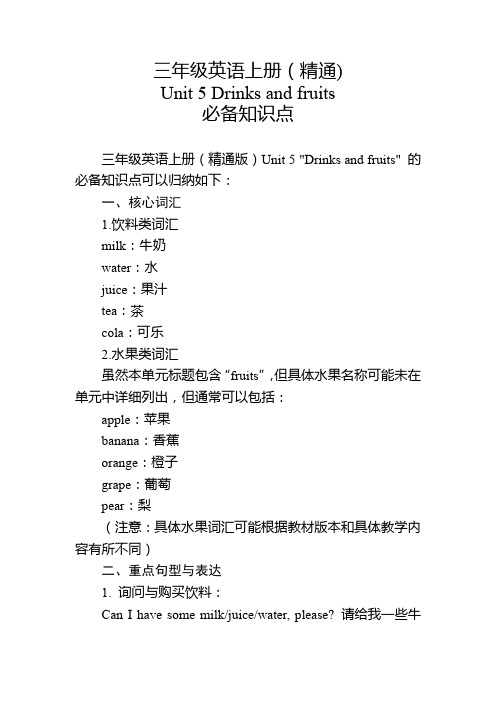
三年级英语上册(精通)Unit 5 Drinks and fruits必备知识点三年级英语上册(精通版)Unit 5 "Drinks and fruits" 的必备知识点可以归纳如下:一、核心词汇1.饮料类词汇milk:牛奶water:水juice:果汁tea:茶cola:可乐2.水果类词汇虽然本单元标题包含 “fruits”,但具体水果名称可能未在单元中详细列出,但通常可以包括:apple:苹果banana:香蕉orange:橙子grape:葡萄pear:梨(注意:具体水果词汇可能根据教材版本和具体教学内容有所不同)二、重点句型与表达1. 询问与购买饮料:Can I have some milk/juice/water, please? 请给我一些牛奶/果汁/水好吗?Let's buy some milk/juice/water. 我们买些牛奶/果汁/水吧。
2. 日常对话:Have some milk/juice. 喝点牛奶/果汁。
I want some tea. 我想要一些茶。
Sure, here you are. 当然,给你。
3. 数量与修饰词:使用“some”来修饰不可数名词(如milk, water, juice)或表示未确定数量的可数名词。
三、语法与用法1. 不可数名词:在本单元中,大多数饮料 (如milk, water, juice)都是不可数名词,因此使用“some”来修饰它们。
2. 祈使句:Let's do sth. 让我们做某事。
例如:Let's buy some juice. 我们买些果汁吧。
Have/Drink some... 喝点/吃些……。
例如:Have some water. 喝点水。
3. 肯定与否定回答:对于Can I...?的询问,常用Yes, you can./No, you can't.来回答。
四、拓展词汇与表达I'd like...:是I would like...的缩写形式,用于表达自己想要的食物或饮料。
人教PEP英语(2024)三年级上册Unit 5 The colourful world考点梳理
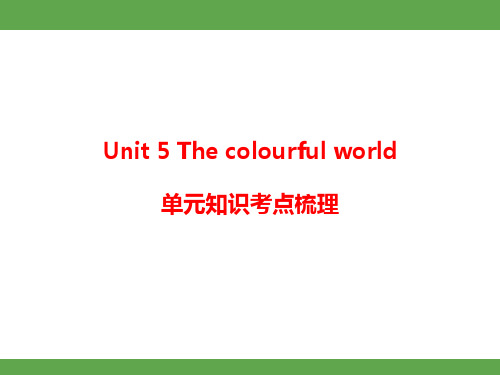
我们喜欢紫葡萄。
你喜欢棕色吗?
返回目录
词 汇 巧 记
例句 I see a brown bear. 我看见一只棕熊。
例句 It’s yellow. 它是黄色。
返回目录
词 汇 巧 记
例句 This is a yellow duck. 这是一只黄色的鸭子。
例句 The sea is blue. 大海是蓝色的。
透 —It’s brown. 它是棕色的。
析 拓展 表示颜色的常见单词还有grey,意为“灰色;灰色的
”。
返回目录
句 型
2. (教材P.52) Look! Red and blue make purple. 看! 红
透 色加蓝色是紫色。
析 [句型结构] Look! 颜色A + and +颜色B + make +颜色C.
拓展 useful 有用的 例句 Use again!再次利用!
返回目录
课
Let's talk
文
翻 译
Sarah: What colours do you
like?
一起说 萨拉:你喜欢什么颜色? 陈杰:我喜欢红色和粉色
Chen Jie: I like red and pink. 。
Sarah: OK. Let’s draw some 萨拉:好的。我们一起画
透 —I like orange and yellow. 我喜欢橙红色和黄色。
析
②—What colours do they like? 他们喜欢什么颜色?
—They like purple and brown. 他们喜欢紫色和棕色。
③—What colours does your mother like? 你的妈妈喜欢
苏教译林版小学英语三年级上册 Unit5 知识点梳理

Unit 5 Look at me
一、单词
1.基础词汇
T-shirt 短袖nice漂亮的Skirt短裙
cap便帽great很好jacket夹克
new 新的Red红色colour颜色
friend 朋友sweater毛衣all都
2.拓展词汇
jeans 牛仔裤smart 时髦的trousers 裤子beautiful 漂亮的pretty漂亮的fancy精美的shoes 鞋子boots靴子
二、基础短语
look at看;瞧it's=it is它是look great 看上去很好
三、句型
基础句子
1. Look at my T-shirt. 看我的短袖。
2. Look at my new skirt. 看我的新短裙。
3. What colour is my T-shirt? 我的T恤衫是什么颜色的?
4. How nice! /It's great! 多么好看啊!/它很漂亮!(感叹句)
5. Look at my cap and jacket. 看我的帽子和夹克衫。
拓展句子
1.They all look great! 它们看起来都很好!
2.Do you like caps? 你喜欢便帽吗?
3.Would you like a cap? 你想要一个便帽吗?。
